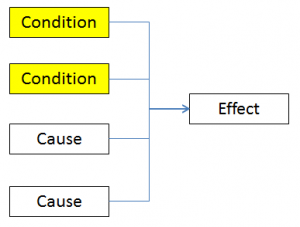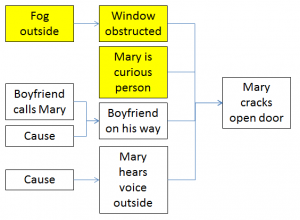Did you ever read about a character making a decision or taking an action and wondered “Why did she do that?” For example, why does the girl in the skimpy dress unlock and crack open her door after she’s seen the TV news and knows there are zombies loose? If you have to ask why, the author hasn’t made the character’s motivations clear enough. Today I thought I’d give you one technique for avoiding that problem.
Engineers have a method called Root Cause Analysis (RCA) they use when something goes wrong with machines or systems they designed–ships sink, spacecraft blow up, cars crash, etc. They review the accident to understand if they could design the machine or system better to lessen the risk. It occurred to me one day that RCA could be applied to fiction writing.
 Imagine an event–one person taking a specific action. Let’s represent that event with a rectangle. For the moment, we’ll call our event the “effect.” For that event to take place, a set of conditions must be present, and a few other events must have taken place first. These can be represented by other box-like rectangles off to the left, connected by lines to the effect box. The prior events can be termed “causes.”
Imagine an event–one person taking a specific action. Let’s represent that event with a rectangle. For the moment, we’ll call our event the “effect.” For that event to take place, a set of conditions must be present, and a few other events must have taken place first. These can be represented by other box-like rectangles off to the left, connected by lines to the effect box. The prior events can be termed “causes.”
Each of the prior causal events are also themselves effects of even earlier causes and conditions. This means there is an endless stream of causes and effects, creating a rather messy diagram of infinite boxes and lines. But for our purposes we can keep it from getting too complicated.
Let’s take our seemingly idiotic girl (whom we’ll call Mary) who unlocks her door in a zombie-infested neighborhood. We put the words “Mary cracks open door” in our effect box. We know some conditions have to be present for that to happen, but some of them are too obvious to write down–Mary has to exist, she has to be inside a house or apartment, the dwelling has to have a door. As you do RCA you’ll become more skilled at figuring out which conditions to write down.
Let’s suppose there are other, less obvious, conditions that lead to Mary’s action. Suppose there’s a storm or fog and the view out her nearby window is obscured. These could be shown as condition boxes with lines connecting to our effect box. Suppose Mary’s personality includes the fact that she’s a naturally curious person. We’ll come back to that one later.
 Aside from conditions, we can think of a few preceding events that might prompt Mary to crack open her door. Suppose she knows her boyfriend is outside somewhere, because he called her earlier and said he’s on his way to her.
Aside from conditions, we can think of a few preceding events that might prompt Mary to crack open her door. Suppose she knows her boyfriend is outside somewhere, because he called her earlier and said he’s on his way to her.
Suppose she just heard a noise from outside, a voice that sounds like it might be her boyfriend. If the call from her boyfriend is one of the prior events, that one will take some explaining, too. Why would he venture out on a stormy night when zombies are about? That event cries out for its own prior events and conditions.
The point is for you the author to think about each major decision or fateful step taken by a character and come up with reasons, motivations (whether they are prior events or conditions) that help explain why the character takes that action.
Remember I mentioned that one of our story’s conditions would be that Mary is a curious, inquisitive person? It’s not enough to just put that in a box on our cause-effect motivation chart. You need to establish that point earlier in your story. Provide some scene, or part of a scene, showing that Mary’s personality includes that trait. Only then will readers understand why she cracks the door later.
When you finish your chart, it should look something like a big ‘greater than’ (>) symbol leading to the final event of your story. Now make sure the manuscript mentions all the events and all the conditions, even if briefly, and even if only hinted.
RCA helps engineers figure out why bad things happen with complex engineered systems, but I think authors can use it to help explain why their characters do things, too. What do you think? Could that technique help you? From personal experience, I can tell you it has helped–
Poseidon’s Scribe
